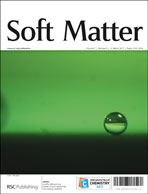We present an investigation of the role of micropatterning on adhesion properties at soft deformable polydimethylsiloxane (PDMS)/acrylic adhesive interfaces. Contrary to what has been observed for low aspect ratio rigid patterns, where the adhesion enhancement was found to only result from the increase of the interfacial area due to patterning, we show that for soft elastic arrays of cylindrical pillars, the elastic deformation of the patterns can lead to a noticeable extra adhesion increase. The effect of the geometrical characteristics of the patterning for hexagonal arrays of PDMS micropillars on the adhesion energy is presented. We show that varying the size of the pattern allows one to tune the adhesion energy, and that this adhesion enhancement saturates when the pillars become too close to each other, due a coupling of the elastic deformation fields inside the underlying substrate. A mechanical model has been developed and found in good quantitative agreement with experimental data, with a unique fitting parameter, the rupture criteria for the adhesive on the top of the pillars. Such a rupture criterion can thus be extracted from systematic experiments on controlled patterned surfaces. This criterion remains sensitive to the chemistry of the surfaces.

You have access to this article
 Please wait while we load your content...
Something went wrong. Try again?
Please wait while we load your content...
Something went wrong. Try again?


 Please wait while we load your content...
Please wait while we load your content...